The content of the article
Garden strawberries are a type of wild strawberry. She has larger leaves and berries, rich in vitamins and minerals. The culture propagates by seeds and rosettes. The plant takes root in any soil, but the size of the fruit depends on the quality of the soil and the amount of nutrients. You can plant strawberries in the middle or end of spring, as well as in autumn. In order for the culture to quickly take root and not die in the winter, you need to adhere to several rules.
Planting material
A simple way to propagate domesticated strawberries - mustache seedlings. In summer, shoots form on the plant. Sockets are sprinkled with a substrate and regularly watered so that they take root. Closer to fall, the workpiece is separated from the mother bush with sharp scissors or a knife. The seedlings are dug up and examined, healthy specimens are selected. Viable blanks have white and elastic roots, a well-developed core and a minimum of 3-4 leaves. Deformed and sluggish sockets are thrown away, they will not survive the winter. The roots of strong seedlings are shortened, leaving 6–7 cm. The shoots are soaked before planting in water or in solutions that stimulate growth.
If the strawberries do not let out a mustache, you can propagate it by dividing the bush. Choose the largest and most dense species and dig up. The root system is carefully cleaned of an earthen coma and cut into 2-3 parts with a sharp knife. Each blank must have a core and full leaves, at least 4 pieces.
The most difficult method of reproduction is seeds. Planting material is harvested independently. Large fruits are picked and waiting for them to ripen. Soft berries of a saturated red shade are kneaded and passed through a sieve, separating the flesh from the seeds. Seeds are transferred to a colander covered with gauze, washed with water. Planting material is sown in prepared pots or open ground. In spring, seedlings appear, which must be carefully looked after. Fortified sockets are dug up and seated. They give a crop in a year.
Soil preparation
It is recommended that strawberries not be planted in areas where eggplant, potatoes, cucumbers, peppers or cabbage used to grow. After such crops, the larvae of insect pests remain in the soil:
- Colorado potato beetle;
- nematodes;
- wireworm.
In the spring, they awaken and begin to multiply actively, destroying the root system of domesticated strawberries. Strawberries take root well in the land in which marigolds, crops, onions or garlic, carrots, beets or radishes used to grow.
Select sites located on the southeast side of the garden. Ideally, if trees grow near the strawberries, which will create a shadow and cover delicate foliage from direct sunlight. Strawberries give a rich crop if it grows in black soil or dark gray forest soil. Like the culture of loamy and loamy soil. The berries will be small and acidic if the owner of the summer cottage chose a sod-podzolic or light gray substrate located in a lowland. Strawberries do not take root in areas with too wet soil, which constantly floods.
The land before planting is dug up and carefully inspected. If bugs or eggs are found in the substrate, you need to treat the soil with ammonia water. The solution destroys the larvae and spores of fungal diseases. Alkaloid lupine can drive away pests. A selected site is sown with a plant, and after a year they dig up and replace the culture with strawberries.
Sites with many weeds are watered with a Roundal solution. On 1 ha take 2 liters of the drug.The tool copes with perennial plants that are firmly rooted and destroys weed seeds.
The substrate is enriched with humus and wood ash 2–3 weeks before planting strawberry bushes. You can use compost or peat. Fresh manure is prohibited, the component produces a lot of nitrogen, which stimulates the growth of green mass, but inhibits the formation of buds.
Sprinkle fertilizers abundantly with fertilizer beds and dig a shovel to the depth of the bayonet. The site is leveled with a rake and left for 3 weeks. To get a good harvest, it is recommended to supplement the compost with potassium compounds and superphosphate. On 1 m take 20 g of the first and 40 g of the second additive. With increased soil acidity, dolomitic lime, approximately 250-300 g, is used.
Strawberries are transferred to new beds every 2–4 years. The land in which strawberries grew is recommended to be sown with grain or onion crops. They help the soil recover and be saturated with nutrients. Strawberries can be returned to the old site in 3-4 years. So much time will be needed for the substrate to be enriched with micronutrients.
Good time
Domesticated strawberries are planted in spring or autumn. In summer, the air temperature is too high. The soil dries quickly, even frequent watering does not help. A culture devoid of water withers and dies.
In spring, strawberry seedlings are planted in late April or May, when the land warms up to a depth of 5-6 cm. In autumn, strawberries are prepared for propagation in September. Some summer residents start planting crops in late August. Autumn seedlings have time to take root and take root during the winter, so the crop is harvested as early as next year.
Preparation and planting methods
Sockets before planting are soaked in a solution of copper sulfate. The drug is mixed with baking soda in a ratio of 1 to 6. The workpiece is diluted with water: 10 liters of liquid are taken per 30 g of the composition. Copper sulfate disinfects seedlings and protects against fungal diseases.
Sockets dug from the ground are sent to the cellar or basement for 12-24 hours. The root system is dipped in a mash of orange clay. 5 kg of the dry component are mixed with water to obtain a creamy mass. The preparation is insisted for several hours, and then smeared with strawberry orange paste. The roots are also wrapped with wet paper so that the shoots do not lose moisture. Dry seedlings can be stored for several days.
Strawberries are planted in the evening, choose a cloudy day. Well, if it rains a little. There are 4 common landing methods:
- carpeted;
- nests;
- separate bushes;
- in rows.
The first option is suitable for people who rarely come to the country. The mustache, which is formed in strawberry bushes, does not break off, but allows you to take root. The culture gradually grows and captures the site. A special microclimate is created, and a layer of natural mulch is formed on the ground. Strawberries planted by carpet should rarely be watered and fertilized. Weeds do not grow on strawberries. The earth is rarely loosened, mainly in autumn and spring.
The carpet method has the only drawback. Berries due to the large number of mustaches and rosettes are gradually fading.
Summer residents who want to get large fruits, choose the method of planting in separate bushes. A distance of 45-60 cm is observed between the beds. Strawberries mustaches are regularly cut so that the plants do not intertwine with each other. The artisanal method is complex and time-consuming. You often have to loosen and mulch the soil with straw, fertilize and water the beds, and also fight weeds.
Thanks to the artisanal method, strawberries intensively develop and bear fruit, and the likelihood of fungal diseases is reduced, because each plant is aired.
To transplant strawberries not after 2-3 years, but after 5-6 years, summer residents divide the site into rows. Between the pits 15–25 cm recede. The row spacing is 40 cm.The method is practically no different from artisanal. Mustaches are torn off strawberries, rows are regularly weeded, plants are watered and mulched.
A rich harvest is obtained when planting strawberries in nests. The largest and fluffy bush will become the core, which is surrounded by other plants. Form a hexagon. The distance between the central and lateral points is 5–6 cm.
With this method, you will need a lot of planting material. A distance of 25-30 cm is maintained between the nests. The method provides a rich crop.
Modern options
Summer residents tired of weed control are advised to pay attention to non-woven material. The invention is called "Spanbond." Dense black material allows air to pass through and traps moisture in the soil, creates a favorable microclimate for strawberry development, but protects it from pests.
Summer residents using "Spanbond" plant strawberries in rows. The land is watered abundantly before work. In dry soil, strawberries do not survive well. Grooves are dug at a distance of 55-60 cm, the substrate is covered with non-woven material and fixed with stones or boards. Cross-shaped incisions with a diameter of 5-6 cm are made in a dense blank. Hands form holes in which strawberry seedlings are placed by hand. The root system is straightened so that the shoots look down and slightly to the side, sprinkled with earth, leaving the core on the surface. The corners of the nonwoven material are neatly spread so that they cover the base of the strawberry. Outside, only leaves remain.
In a similar way, strawberries are planted without nonwoven material. The holes moisturize abundantly, straighten the root system and sprinkle with a wet substrate. Seedlings are abundantly watered so that they better take root. Sprinkle with fresh straw on top. Thanks to mulching, the soil retains moisture longer, and the roots do not overheat and do not freeze.
Tip: An ammonia solution in which sockets are soaked to prevent fungal infections can be replaced with garlic water. The product is prepared from 2-3 chopped cloves and 1 liter of liquid base.
If the summer cottage is small, and you need to save space, it is recommended to build a pyramid from old tires or boxes. The height of the structure can reach 10 m. The containers are filled with a nutrient mixture, which includes peat, sod land and humus. To make the substrate more loose, a little sand is added to it.
The distance between the bushes in containers is 15–20 cm. The volume of land for the root system is 1.5 liters. In winter, the structure is dismantled, and the components are buried in the ground and mulched with fallen leaves. In the spring during the period of frost, the containers are covered with a film or non-woven material.
Growing seedlings in early spring
Summer residents who want to harvest in May or June build mini-greenhouses for strawberries. The earth is enriched with fertilizers, dug up, and after 3 weeks, beds are formed. Make small arcs from a wire with a radius of 50-60 cm, set at a distance of 1 m.
The covering material is fixed to the frame using a jute rope. One side of the film is pressed to the ground with iron slats or stones, the other is left free so that it is convenient to plant strawberries and care for the crop. The ends of translucent polyethylene are tied with ropes and fixed with pegs, and then buried with earth. The improvised greenhouse will be warm and humid. The film attracts sunlight, traps water and protects against weeds.
A thermometer is attached to the inner wall of the greenhouse. If the thermometer shows +25 or higher, the free edge of the film is opened and aired in the greenhouse. Strawberries love warmth, and because of the heat weakens and gets sick.
The greenhouse is ventilated on sunny days, and when the bushes bloom, the covering material is removed for the whole day, and returned to the place in the evening to protect the seedlings from frost. The film is completely removed after the formation of berries.
In the early morning before the onset of heat, the culture is poured with heated water. You can’t cold, otherwise strawberries will get sick. The beds are moistened once a week. The earth is periodically loosened, removing weeds and dried bushes. In autumn, strawberries grown in a greenhouse are covered with a mixture of fallen leaves, straw and spruce branches. Before mulching, the soil is enriched with peat and compost.
Seedling seed
Hybrid varieties of strawberries propagated by rosettes and division of the bush. Other varieties can be obtained from seeds. It is easy to grow seedlings. You will need a container with a depth of 10-15 cm. The container is half filled with a substrate for seedlings, the soil is watered abundantly.
In the ground with a toothpick make small grooves or indentations at a distance of 5-6 cm. Seeds are laid in the pits, they are not sprinkled with soil. The container is covered with glass and taken to a warm room. A container with young shoots is placed on a lighted window. The transparent cover is removed so that the seedlings breathe.
Seedlings with 2 real leaves are dived into separate pots. Every 2 weeks fertilizers for strawberries are applied to the soil. Grown and matured bushes are planted in open ground in spring or autumn.
Care
Beds with strawberries are advised to be surrounded by plants that repel pests. Slugs do not tolerate the smell of parsley, Colorado beetles and other insects do not like garlic, radish, marigolds, onions, sage and spinach. Pests scare away beans and lettuce, as well as cabbage and beets.
In bushes planted in the spring, tendrils and inflorescences are removed in the first year. They prevent the plant from rooting and strengthening. After 15 days after planting, the earth is fertilized with mineral or organic feeds. Flower shops sell vermicompost. At home, fertilizer is prepared from fermented grass or bird droppings. The workpiece is soaked in water and insisted for several days. The concentrated solution is diluted and added to the substrate after weeding and heavy watering.
The earth around the strawberry bushes needs to be mulched. The soil is sprinkled with pine or spruce needles. The aroma of needles scares away the bear, the Colorado potato beetle and other pests. Spruce needles are replaced with straw. The workpiece is first soaked in water and laid out in a thin layer on a film or sheet of iron, left in the sun. Wait until weed seeds germinate. Clean and dry straw is scattered between the rows and under the bushes. In a similar way, hay or dried grass is used.
Garden strawberries are watered from a watering can 2-3 times a week. The hose stream is too strong; it can damage the leaves and the core. The watering can is replaced by sprayers: fan, swaying, circular or rotary. Strawberries will also like drop watering. The main thing is that the water is warm and settled, without impurities of heavy metals.
You can plant remontant strawberries in spring and autumn. Before gardening, the earth is enriched with fertilizers, and then mulched with straw or coniferous needles. Young strawberry seedlings are watered and regularly fertilized, protected from cold and pests, and in the first year they pluck the antennae and inflorescences. Thanks to this, the culture quickly takes root and adapts to new conditions.
Video: proper strawberry planting

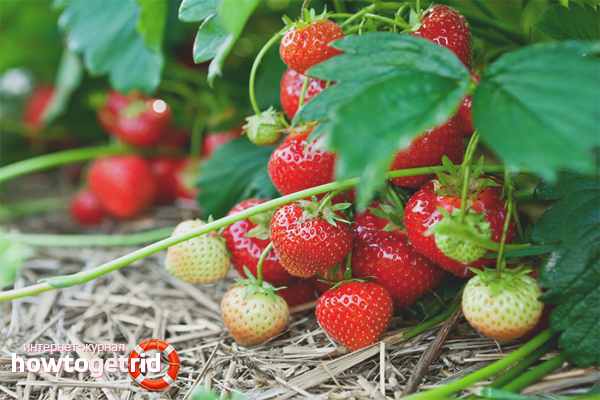

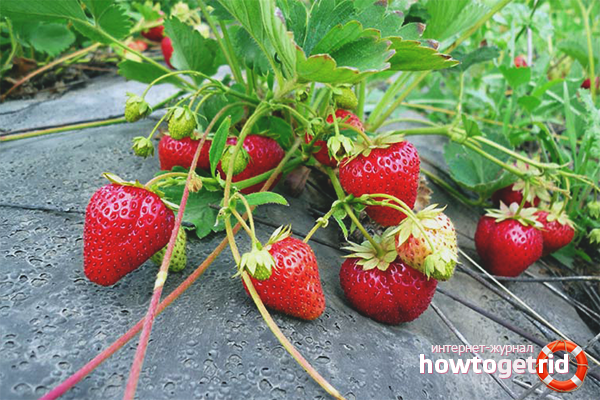
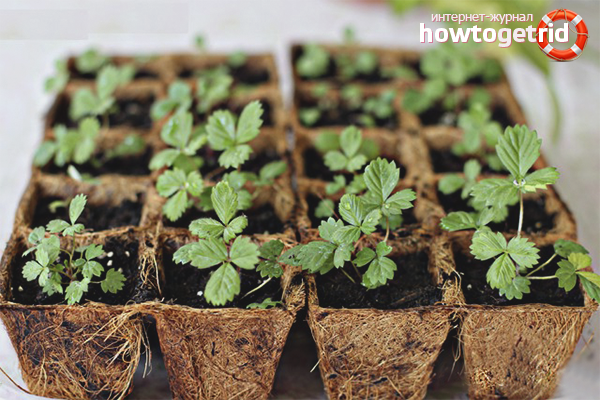
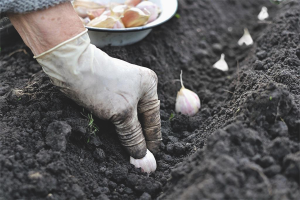
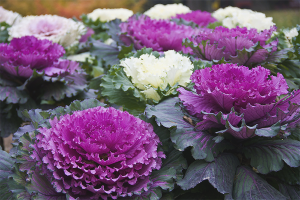

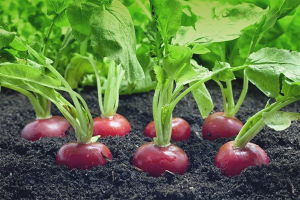
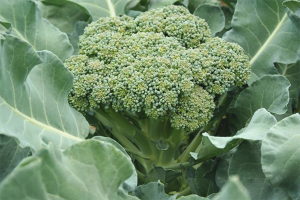
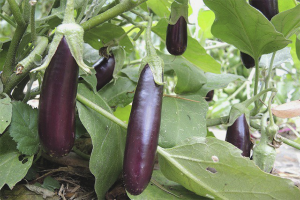

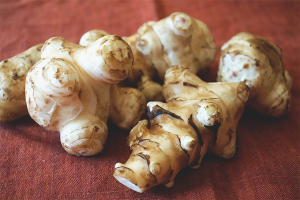
Submit